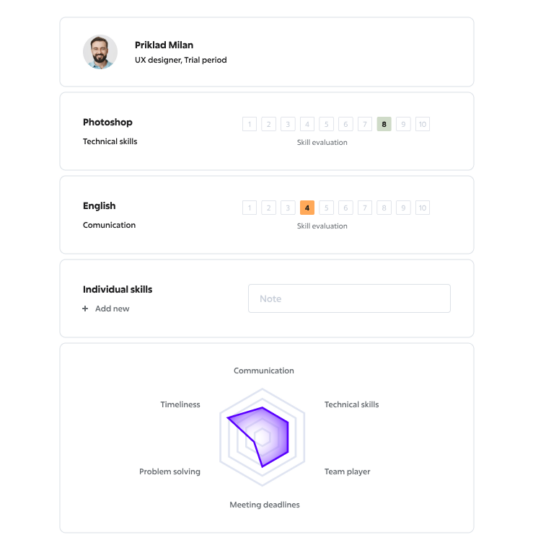Recruitment
What is recruitment?
Recruitment is the process of sourcing, screening, and selecting qualified candidates for a job or position in an organization. It is a fundamental aspect of human resource management and plays a vital role in building a talented and capable workforce.
What is the recruitment process?
The recruitment process consists of several stages, which we will discuss below. It is important to note that they can vary from company to company based on their specific needs, industry and size. However, the main components of attracting, screening, selecting and onboarding candidates remain consistent in most recruitment processes. When we talk about the recruitment process, we distinguish the following stages:
- Job Description: Before starting the recruitment process, organizations develop a job description to define the requirements and responsibilities of the vacant position. This analysis helps determine the necessary qualifications, skills and experience needed for a potential candidate.
- Sourcing: Sourcing involves identifying and attracting potential candidates for a given position. This can be achieved through various channels such as job portals, social media platforms, employee referrals, professional networks, career fairs and recruitment agencies. The goal is to reach a broad range of candidates and generate a sufficient number of applicants.
- Screening: Once applications are received, the screening process begins. This involves reviewing resumes, cover letters, and application forms to assess candidates’ qualifications and suitability for the position. Screening may also include pre-employment tests, assessments, or preliminary interviews to further narrow down the pool of candidates.
- Selection: During the selection phase, recruiters or hiring managers interview shortlisted candidates to assess their skills, knowledge, experience, and fit with the organization’s culture. Multiple rounds of interviews may be conducted, involving various stakeholders within the organization. Other selection methods, such as reference checks, background checks, and psychometric assessments, may also be used to obtain additional information about candidates. After the selection process, recruiters or hiring managers make the final decision on which candidate to hire.
- Job Offer: Once the candidate is selected, the organization extends the job offer and outlines the terms of employment, such as salary, benefits, start date, and any other relevant details. During this phase, negotiations may take place to reach a mutually acceptable agreement.
- Onboarding: Once the candidate accepts the job offer, the onboarding process begins. This involves familiarizing the new employee with the organization’s policies, procedures, culture, and work environment. The goal of onboarding is to help the new employee integrate smoothly into the organization and become productive as quickly as possible.
What to look out for when recruiting?
When it comes to recruiting, there are several key factors to consider. These include clearly defining job requirements, assessing the candidate pool in terms of quantity and quality, evaluating the employer brand to attract the best candidates, reviewing the effectiveness of the recruitment process, and ensuring a well-structured selection process.
By paying attention to these aspects, organizations can enhance their recruitment efforts and increase the likelihood of attracting and selecting the right candidates for their positions.
What specifics does digitalization bring to the world of recruitment?
Recruitment is a very broad topic, but let’s take a closer look at the new possibilities that digitalization brings to this area.
1) More options for using online tools
Whether it’s online interviews via various platforms, ATSs that run directly online via a web browser, or interactive homework assignments or psychometric tests. All of this is made possible by online recruitment (or e-recruitment), which makes the recruitment process more interactive and, dare I say, more flexible.
2) More options for strengthening the employer brand and HR marketing activities
More than ever before, applicants look at the profile of companies and make their choices. Companies must pay attention to their external image and the way they present themselves as an employer. Within the scope of HR marketing activities, one could also talk about recruitment marketing, which is specifically focused on strengthening their attractiveness towards potential applicants.
Benefits of a strong HR system with integrated ATS
When you finally find your dream candidates and offer them a job in your company, what better way than to integrate them as users in your HR recruitment software? Of course, including all the details you have collected during the recruitment process. At Sloneek, this can be done in a few clicks thanks to the integrated ATS software (recruitment platform). Recruitment is largely automated, so-called automated recruitment, and HR gets more time to devote to thorough screening of candidates, without having to waste time sorting CVs manually and other administration associated with recruitment. Especially in today’s era, when everything runs online and we are witnessing a digital revolution, online recruitment and an automated recruitment process are inevitable for companies that want to keep up with the times.
Plus, once you hire a new colleague, you can immediately assign them an onboarding checklist to help them get up to speed as quickly as possible. Our ATS administrators also love the talent pool, a place where you can easily store contacts of promising candidates you’ve collected during recruitment, and automated email templates.
We are here for you
Can we help you?
Our experts will answer questions, show you Sloneek , and help modernize your HR.
- Superior onboarding
- Introduction of all functionalities
- Presentation and offer tailored to your HR
- Answer any questions








